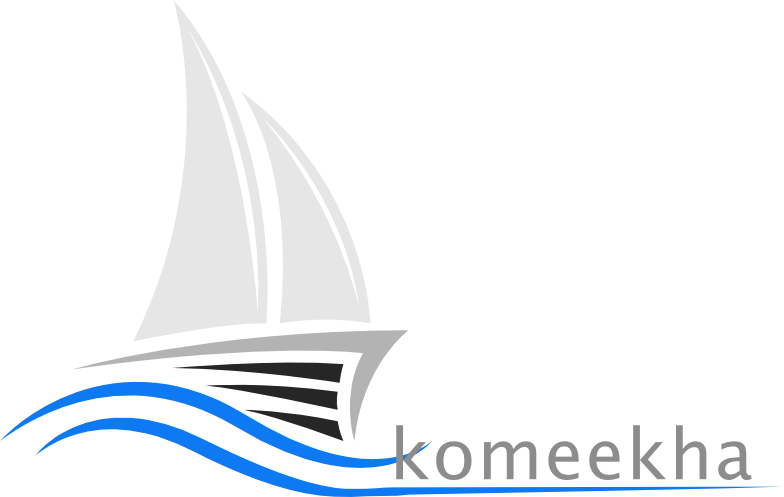February 23
With a heavy heart we said our goodbyes and hugged Harald and Melitta two days ago. We had a happy, memorable vacation together. We promised many more.
Before heading out of St. Maartens yesterday, we provisioned for the next few days: I found a fresh fish market (tuna, mahi-mahi, shrimps), and the usual groceries. Just to give you a glimpse of our time perception now: we went to a new grocery store beside a casino resort; the grand casino property we had to cross extended our walk a lot longer than expected; with our full buggy in tow, we were surprised by big grey clouds over the nearby mountains before we reached our dinghy; no problem, we were passing by a bar at the casino; we stopped for a beer to let the rain pass us by; then continued our way to the dinghy. It seems that now, not much bothers us: we get lemons, we make lemonade ... and ceviche, margheritas, etc. LOL!
The sail to St. Barts, only 15 miles, was a nice trip in the morning. After clearing customs, we discovered the town. Wow! St. Barts is the richest island of the Caribbeans. Stores like Hermes, Bulgari, Dior, Cartier, Louis Vuitton line the streets. Multi-million dollars yachts, three times bigger than our house, line the shores. Many beautiful and young people, many women with botox touch-ups, sugar daddies, yummy mommies, they're all here in the winter, in Europe in the summer.
Last night, we treated ourselves to a very nice restaurant called La Petite Plage. Sitting on their patio, overlooking the illuminated yachts, sailboats and houses in the mountains, we tasted some quality olive oil with buns, grilled mahi-mahi, scallops in a jus of watercress, house chocolate mousse and mille-feuilles. Good food is one of my passion. That was a real treat.
To conclude yesterday: It's interesting to look at all this wealth and veneer; but it's not a past-time that attracts us for more than a day. We prefer open and natural spaces, real and authentic people. So today, we ventured outside of this buzzing centre. We put our walking shoes and swung our backpacks.
Since we left Boston, St. Barts is the first place that offers recycling. You imagine: all the places we've been since Boston (along the US coast, Bahamas, Exumas, Puerto Rico, US Virgin Islands, etc.) don't have the facilities for recycling - or it's not important enough to them to make it easily available to transients. Our garbage had therefore increased a lot: all those beer cans, wine bottles, food cans/wraps take a lot of space. I was not very comfortable with so much garbage. At least, we didn't have water bottles as we make our own water through an osmosis system and use our own bottles.
Plane landings are getting very entertaining on the islands. As the islands are small and mountainous, runways are shorter and near water/beaches and mountains. For example, in St-Martin, people love to stand on Maho Beach where planes are just a few hundreds feet over their heads before landing on a short 2,100 metre runway. In St. Barts, it's the mountain that challenges plane pilots. A small mountain pass crossed by a busy road is the landmark that pilots aim at. It takes a precise angle of approach to hug the side of the mountain before landing. Again, the runway is as short as the one at St-Martin before the ocean beach. From our vantage point, on approach, it looks like the planes will crash on the mountain side.
We're leaving St. Barts in a couple of hours (16h00) for Antigua, a 14-hour sail. We're choosing an overnight sail again for a better wind angle. This should allow us to sail without the engine and make good progress. Both Frank and I have never visited this island. It'll be interesting to discover it together.
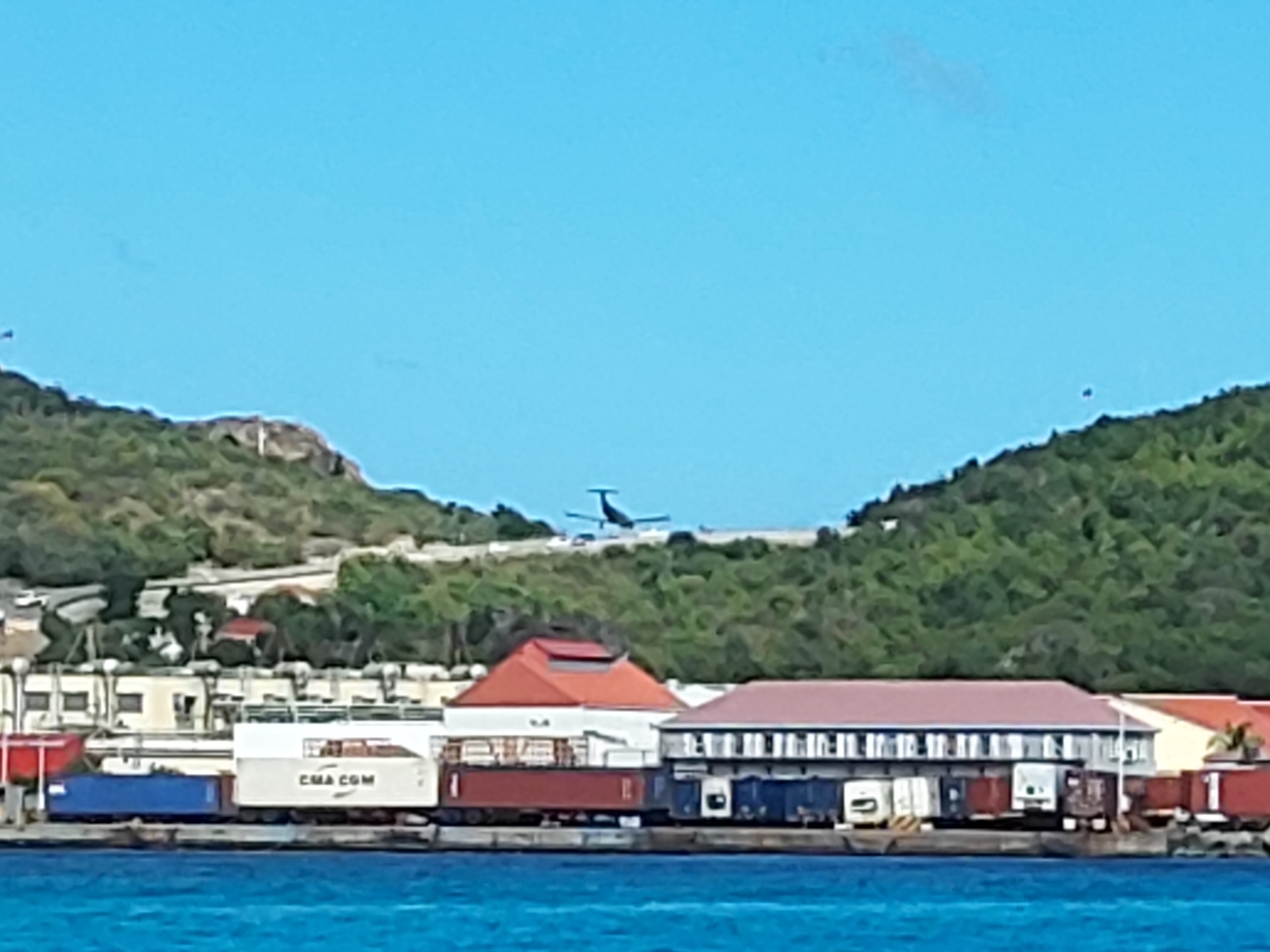

February 15
So much happiness when we spend time with Frank's cousin Harald and his wife Melitta. We get along so well. Harald and Melitta are easy going, happy people, always something interesting to talk about. They flew from Florida after a three-week bus tour in Mexico. It took a few days for the four of us to catch up on news, vacation and sailing stories, plans for the next two weeks. Frank is constantly juggling the three languages.
We spend our days visiting the neighbourhood, Philipsburg, Marigot Bay and its Fort St. Louis, spending hours at the beach and beach tiki bars. We're getting pretty good at picking the best places for margheritas and rum punch. LOL! The French side - St-Martin - has many more beautiful shops and restaurants. I finally found a nice bathing suit with sarong and chemise to match.
Two days ago, we had planned on continuing our journey South with Harald and Melitta to St. Kitts then Guadeloupe where they would have caught their flight back to Germany on Feb. 21st. However, after a few miles of winds and waves, our crew were not feeling so well and could not sustain this rolling sea for many hours; so we decided to turn back to Simpson Bay Lagoon where they'll spend the remaining days with us. They were able to change their flights leaving from Guadeloupe to leaving from St. Maartens.
The down side of sailing is that you have very limited options for long distance land transportation. Depending on distance or destination, sometimes a cab or the local bus system works; but visiting a whole island requires a car rental. We tried to rent one a few days ago but many places had none left. We succeeded in getting a car for tomorrow. Can't wait to drive through the mountains, stop by the beaches, snorkel, taste some French cuisine.
I like the attitude of drivers on the islands. They are courteous and patient. As soon as someone tries to cross a street - not necessarily at an intersection - cars will stop. There are assigned bus stops but bus drivers will stop whenever you ask. Again, no car behind honks in frustration. Actually, whenever I heard a car honk, it was to greet another driver. It's Island Time, no one is in a rush. Well, those in a rush ride scooters: they zigzag through traffic or zip in the middle of the road. Beware when you hear their motors!
For 40 years, St. Maartens hosts the annual Heineken Regatta (March 2-5). There are more than 37 countries represented from olympic medalists, world champions to family live-aboard cruisers. The race motto is Serious Fun. Some race classes are more focused on "fun" than on "serious". Some participants race hard during the day then play hard at night. Our friends on the sailboat Doogie (mentioned in my previous blog), who have a lot of regatta experience, will volunteer here this year. Frank and I love to volunteer in sports and social events; there's always a positive, energetic atmosphere; staff and volunteers are very nice and it's really fun. We are considering volunteering in regattas when we're in the Caribbeans in the future years.
Through Doogie, we met new friends on a sailboat called Ambition who come from Montreal. He speaks English, she speaks French. You should have heard the eight of us around burgers and beers talking in three languages. Merrill and Maryse have been cruising the Caribbeans for many years and keep their sailboat off season in Antigua. As usual, when I meet veteran cruisers I ask them how they prepare their boat for the rainy season in storage (April to October). Usually the answers I get are helpful but not expansive, all verbal. I finally found the treasure trove of information from Merrill and Maryse! They have lists of cleaning products and instructions both for inside and outside the boat. Wow! This is such a generous gesture from them. We appreciate it so much! We're eager to share it with other new Caribbean cruisers like us.
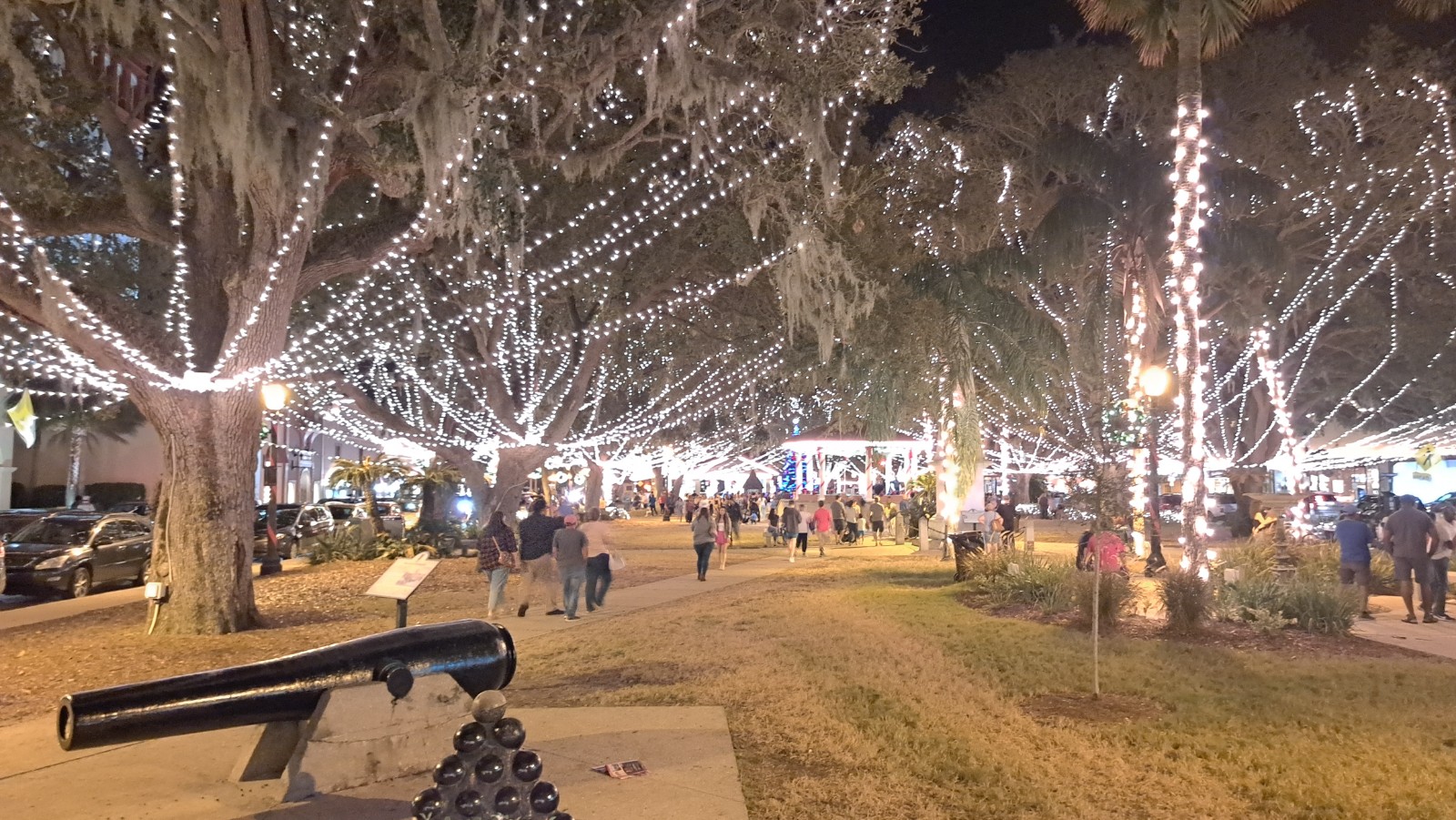
November 30
I loved this city! Again, there's a lot of history and cobblestone alleys. The cuisine is so delicious. We visited a small distillery of bourbon, vodka and gin. The visit was interesting. We like the place so much that after a happy hour there, we decided to stay for dinner. At night, the whole downtown is lit by tiny lights on each tree and each house. In the morning, all businesses are out early to clean their parking area and section of the sidewalk. We got wet a couple of times.
Bicycling in the city was a bit of a challenge. We didn't see any dedicated bike paths and the streets are narrow. So we often biked on sidewalks which brought its own challenge. We figured out how to attach our buggy to Frank's bicycle. Grocery shopping is a lot more fun that way; and we can shop further away.
Before we arrived in St. Augustine, we had to travel in a very shallow section of the ICW called Jekyll Creek. We had read a lot of reviews about boats going aground. This section is only 2 NM long; but travelling only an hour and a half before low tide, it felt much longer. I was at the helm. I learned something during this experience: when I'm afraid of something, I need to put myself in a worst situation and bear it for a while. Hopefully, if I succeed my initial fear no longer exists. Example: We need a minimum of 4.9 feet before we touch ground and can't move forward. We prefer water of at least 6 feet; less than that, I start worrying. When we travelled on Jekyll Creek and my depth sounder kept showing 6.0, then 5.5, then 5.2, 4.9, 4.6!!! Miraculously we didn't run aground. After that, it showed 5.5 for a few minutes (felt like an hour!). At the end of it, my fear of depths less than 6.0 was no longer there. I couldn't believe I felt relieved with a 5.2! Of course, if there are rocks at the bottom, it'd be a whole different experience ....
During our journey to St. Augustine, we passed by another naval base. We saw a few enormous floating garages. They are for submarines! Really cool!
We left St. Augustine this morning after filling up with fuel and water. We'll travel for 4-5 days until we arrive at Vero Beach where we plan on visiting Frank's uncle. Tomorrow will be a bridge day. We're going to cross 9 bridges in that number of hours. The ICW bridges are either 65 feet high (no problem) or pivot/draw bridges of 7-20 feet high. Before we arrive at a pivot or draw bridge, we call the operator with our marine radio to request an opening. Some bridges in bigger cities don't open during morning, noon and afternoon rush hours. We drop the anchor and wait. We're in no rush. Life is good.
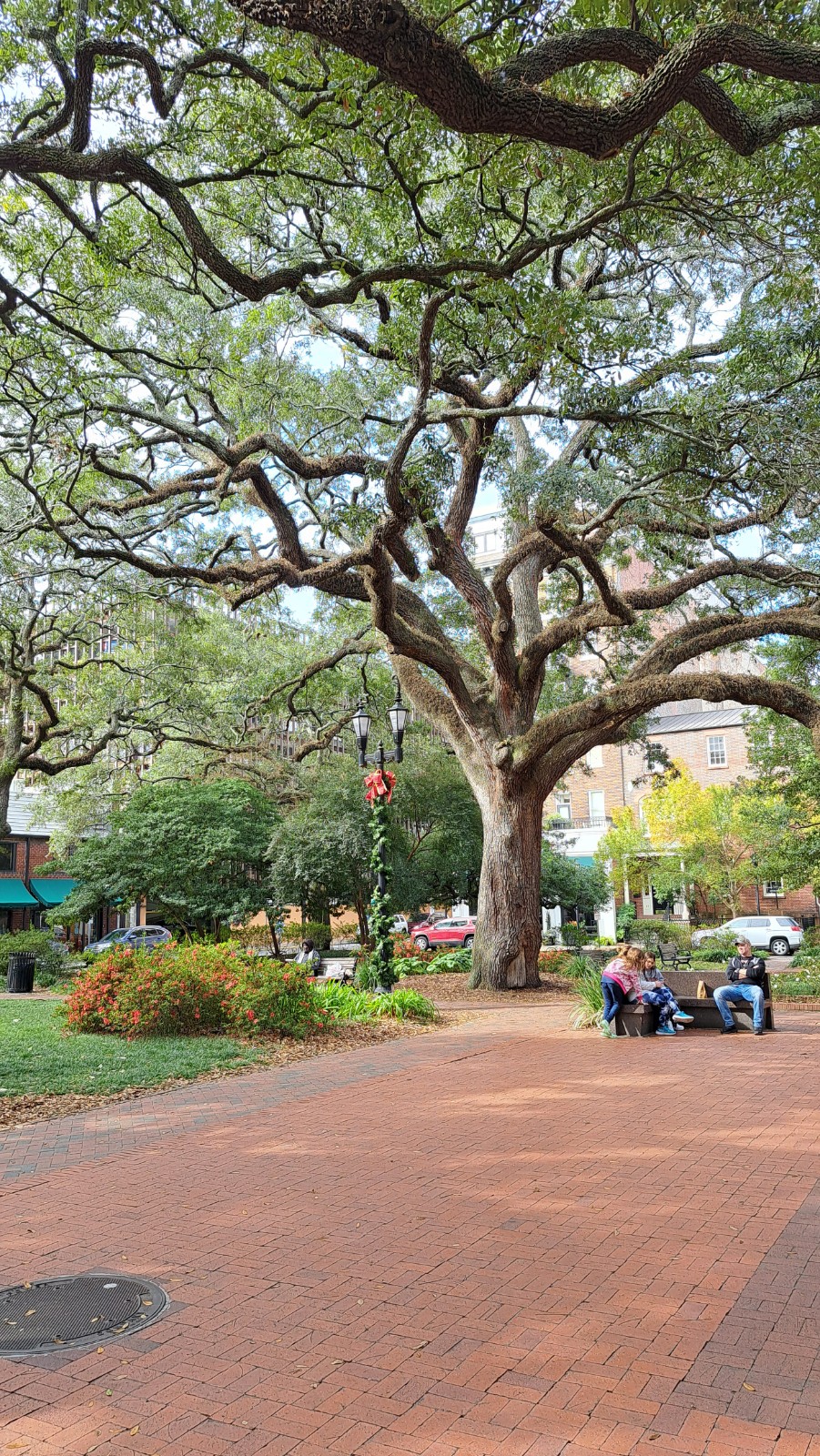
November 23
In my previous blog, I talked about things that are changing as we head South. I talked about language, trees and birds. I forgot two other things that have changed: cuisine and guns.
It's surprising to me how I had forgot to talk about cuisine, as food is one of my passion. Cuisine has changed to, I wouldn't say more flavorful but, different flavors: from oragano/sage/dill/basil to chili/cayenne/chipotle/cumin/paprika; from pork/breakfast/italian sausages to andouille/smoked sausages; from pasta to rice and beans and grits. Also, the quantity of food is so much more. I guess locals get used to it. But for me, it's way too much food. Still, we love it all!
As for guns, not that we've seen any so far but there are "no concealed weapons" signs in many public buildings we enter (restaurants, shopping malls). Hum! It makes me a bit uncomfortable. I think I'd walked away from any situation where hot tempers arise. Just in case ....
<span;>Before we arrived in Savannah, we sailed overnight on the ocean from Charleston. I don't really know the reason for the obvious discrepancy between what we thought the weather/waves forecast would be and what actually we got; but it was not fun at all, actually pretty tiring and frustrating. The winds were supposed to move from starboard close haul (30-40 degrees right side of boat, slower speed) to aft (back) by 2:00am. It never moved from close haul; yet waves were coming from portside (left side of boat) and bow (front). Also, waves were supposed to be less than a meter high; we got 2 meter high from the side and the front. Remember, in one of my blogs, I mentioned some trips feel like a metronome, a bronco ride or a hot knife through butter? Well this one felt like a bronco ride, for 6 hours. In a bronco ride, I can't cook or make coffee in the morning. Not good. Then, by the time we tried to go inland (noon by now), the winds and waves were against us so we had to tack all the way in. We wasted a good 3 hours. Not fun! No more night sailing on the ocean for a while now. I need a break!
The break was 3 nights at the Thunderbold Marina in this Savannah suburb. It was only 10 kms bike rid to downtown Savannah. I liked the city but honestly I found Charleston more quaint and fun. Savannah does have a few original buildings and much history of course; but it also had a lot of newer hotels and infrastructures that tampered down the cozy, homey feeling of Charleston.
We used the Uber transportation service for the first time today. This is so convenient and interesting. You have the convenience of phone apps: easy to set up and pay and realtime location and predicted time of arrival of your Uber car. And you meet new drivers: different personalities and life experiences. Also, compared to taxi where you pay by the minute and kilometers, Uber is prepaid; so you don't care what roads the driver takes; you already paid for your ride. Very colourful experience! It's like B&B's and Airbnb's where each location is new people and new stories. Can't wait for the next one!
Frank is in heaven. He's got new electronics to figure out their settings and installation: IridiumGO, a new wall-mounted smart tv, etc. He loves that kind of stuff. If you need to set up, repair and troubleshoot some electronics, ask Frank. You'll make him happy.
At the end of my last blog, I mentioned our new purchase of an IridiumGO. While we're in the US, you can contact us through our cell phone: text, call, email. When we leave the States, this cellular communication will not always be available. Hence, IridiumGO. For many offshore sailors/boaters who have families and friends who care to know where you are and what's going on, it's a must. At this time, I can't give you a lot of details until Frank figures it all out and explains it to me. What I can tell you is that with IridiumGO those who care can track us down, text and call us with the satellite network of IridiumGO instead of the usual cellular network. For us, IridiumGO can also give us ontime weather forecast through PredictWind. Bottom line, IridiumGO ensure constant communication with family members.
Oh before I forget, 2 more things to mention. In my New York City blog, I mentioned that I walked by a known actor but I couldn't remember his name. I saw him a few days ago in the series called "Young Sheldon", a prequel to the Big Bang Theory. The actor's name is Richard Kind.
The other thing is about marina wifi's. They either have very little bandwidth or don't work at all. So don't think you can rely on them.
Our journey South continues tomorrow morning through the ICW for a few days, until our next stop for provisioning and laundry. Talk to you later! xxxx
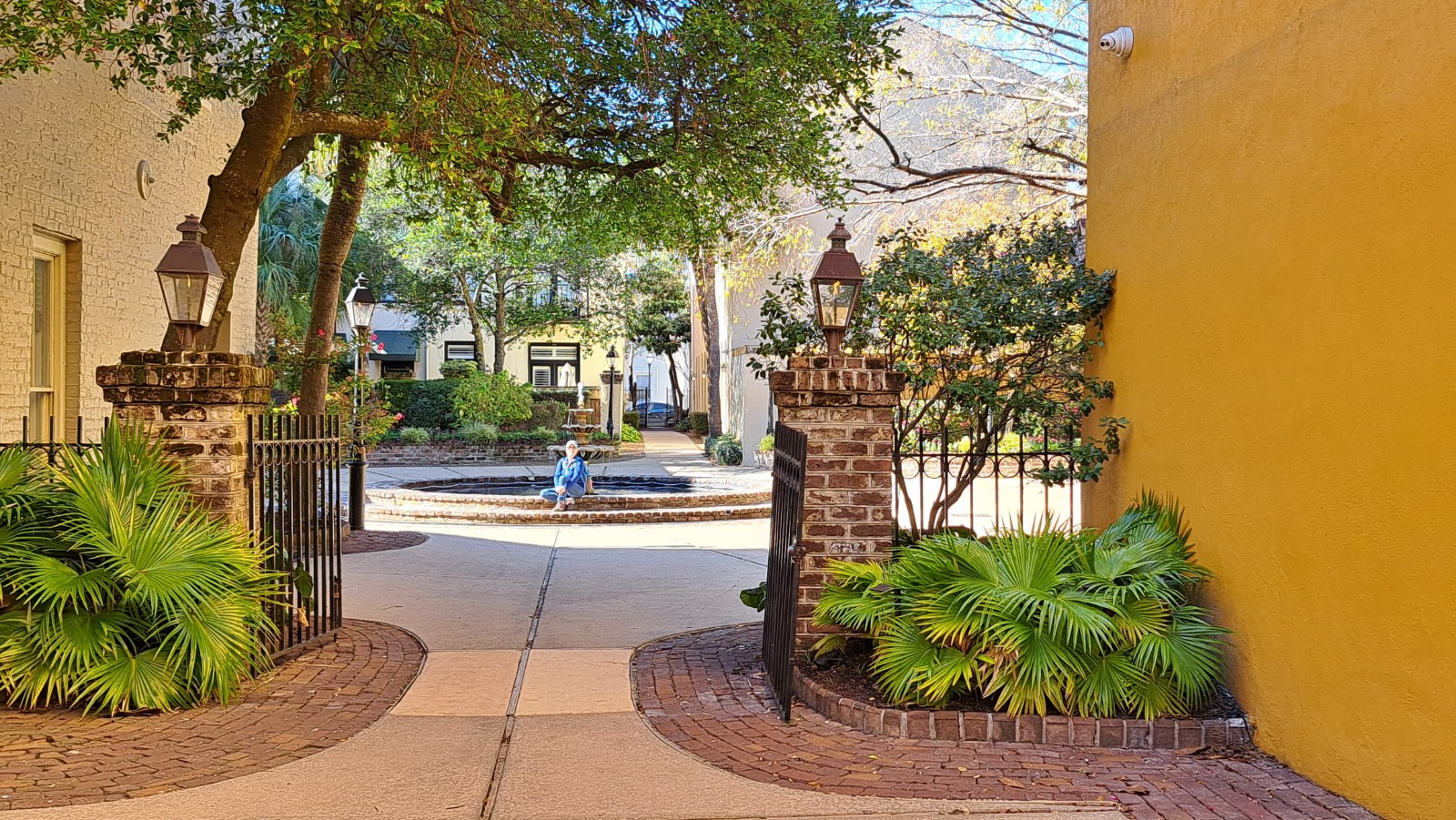
November 19
There's was no point writing a blog before we got to Charleston and experience all the fun and history it offers. Before I get into it though, I want to mention some of the little changes that I noticed recently.
First, there's the language. As we enter the Southern states, we depict the Southern dialect. A lot of "yall" for "you all" even though we're just the 2 of us. There's also a distinct drawl as they speak. We're beginning to need to pay more attention to ensure understanding.
Second, there are different birds and their songs. We're now seeing a lot of long neck, long leg birds like the pelican, the egret, the heron and the ibis. The bird songs I hear remind me of early mornings on resorts in Dominican Republic.
Third, there are the trees. Besides the magnolia, I'm not very familiar with trees. Many trees along the ICW have their roots exposed, not as much as what you'd find in the everglades though. Many trees have that distinctive moss called Spanish moss. Many of them look so strong and old. Looking at them, I wonder what kind of lives people led when these trees were saplings: slavery? Civil War? Floods and hurricanes?
Even though we had some warm weather back in Norfolk, it got cold again in the following days, weeks. To the point that here in Chaleston, we stayed in a marina for 2 nights just to have electricity and plug the heater. With nights of 4-8 degrees celcius, we needed it. We're back to wool socks and tuque; hopefully, not for much longer.
Charleston has this beautiful Southern architectural style you often see in ads for New Orleans: old mansions and churches, old streets, many restaurants. Charleston boasts about Rainbow Row (row houses of multiple colours), the Battery (walled boardwalk by the water), the French Quarter (beautiful alleys, delicious food, narrow cobble streets, horse carriage tours, old houses) and a darker side, the slave market.
We visited the Old Slave Mart Museum. It is housed in one of the slave market hall. There are two eras of American slavery: Trans-Atlantic (banned by Congress in 1808 but frequent smuggling thereafter) and domestic (mostly after 1808, from Virginia/Maryland to Deep South Alabama, Georgia, etc., triggered by crop/labour changes in both regions). Slaves came from Africa and the Caribbean islands. Charleston was one of the biggest slave market. We learned that the trader - the market owner - would heal, clean, clothe and feed slaves before a sale to ensure the biggest profit. Price was set by age, build, colour and skills. We knew that the Northern states were the first to abolish slavery. After the Civil War, slavery was abolished in United States in 1865. It was difficult to visit the museum and now to write all these facts without emotion.
Charleston - Charles Town first, for King Charles II - was founded in 1670. Settlement was difficult and slow due to epidemics such as malaria, yellow fever and smallpox, tropical storms and hurricanes. In the 1700's, it started to prosper thanks to slavery and export to Europe (pine timber, tobacco and textile). The Civil War, which started at Fort Sumter in Charleston, devastated the city and its economy. During the years following the abolishment of slavery and the war (1865), as a major part of the population was of dark colour in Charleston (57% in city, 73% in county), much violence between blacks and whites occurred. In 2018, Charleston City Council apologized for its role in slavery.
We walked the French Quarter all day. For dinner, I tried grits for the first time, with shrimps. Grits is a typical Southern staple made of ground corn. It is used as a sidedish instead of potatoes or rice. I think it's the type of food that is ordinary by itself, that needs other ingredients to elevate it. The one I had last night was mixed with jalapeno cheese - yummy. I'll try it more often to decide whether or not I want to add it to our diet. We finished the evening in a piano lounge with red wine and chocolate cake. Perfect! One thing that greatly surprised us is that we couldnˋt find a typical French patisserie in the whole quarter. Oh well!
We're leaving Charleston tonight for an overnight sail to Savannah. We should be there by noon tomorrow and will spend a few days. Frank ordered an IridiumGo to be picked up at the marina. I'll tell you all about it in my next blog in Savannah.
